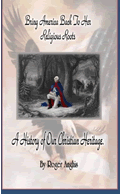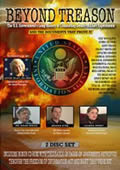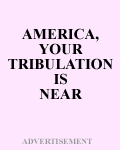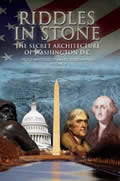PART 27
By
Pastor Roger Anghis
November 20, 2011
NewsWithViews.com
The Judges Part 1
In the next couple of chapters we will discuss the judges of America. Today’s judges seem to have no regard for the Constitution or the Bill of Rights. They have ignored 350 years of judicial decisions concerning religion and even their constitutional boundaries in their adjudications. They have used international laws to decide cases, which is a violation of their oath, they have ignored previous court decisions and have completely redefined the First Amendment.[1]
Several jurists have commented on this improper interpretation that was issued in the 1947 Everson v. Board of Education. One jurist, Judge Gallagher, stated concerning the Everson decision:
Much has been written in recent years . . . to ‘a wall of separation between church and state”. . . . It has received so much attention that one would almost think that it is to found somewhere in our Constitution.[2]
Justice Potter Stewart made a similar statement when he declared:
I think that the Court’s task, in this as in all areas of constitutional adjudication, is not responsibly aided by the uncritical invocation of metaphors like the ‘wall of separation”, a phrase nowhere to be found in the Constitution.[3]
Even Justice William Rehnquist commented that this phrase is a ‘misleading metaphor,”[4] and then further defined his statement saying:
But the greatest injury of the ‘wall’ notion is its mischievous diversion of judges from the actual intentions of the drafters of the Bill of Rights. . . . The ‘wall of separation of church and State” is a metaphor based on bad history, a metaphor which has proved useless as a guide to judging. It should be frankly and explicitly abandoned.[5]
It is obvious that according to these jurists that the courts have gone beyond their constitutionally allowed parameters. We will look at the lives, beliefs and actual comments of jurists of the Founding era to see if these modern jurists have followed the established guidelines of established jurisprudence.
The first jurist I want to look at is the first Chief Justice of the Supreme Court, John Jay.
Chief Justice John Jay: John Jay was not only a Founding Father but a member of the First and Second Continental Congress and even served as President of the Continental Congress. His authorship of part of the Federalist Papers expedited the ratification of the Constitution. In 1777 he was instrumental in writing the Constitution of New York and was Governor of New York from 1795-1801.
He was one of the negotiators of the peace treaty with Britain along with Benjamin Franklin and John Adams. When America was operating under the Articles of Confederation he was Secretary of Foreign Affairs, and he was U.S. Minster to Spain. He was President of the Westchester Bible Society in 1818 and President of the American Bible Society in 1821. He was appointed by President George Washington as the first Chief Justice of the Supreme Court.
The exclusion of religion from laws and politics was not practiced by the Founders. Their Christian faith was so much a part of their daily lives in all areas that it was impossible for them to separate it from government, education, public or private life. On October 12, 1816 Chief Justice Jay commented:
“Providence has given to our people the choice of their rulers, and it is the duty, as well as the privilege and interest of our Christian nation to select and prefer Christians as their rulers.”[6] (Emphasis added)
While serving as Chief Justice He felt that it was necessary for clergy to always be in attendance when Court was held. It was common in that day for the Supreme Court Judges to travel to the different districts instead of making the people travel to the capital as is done today. This was determined because the Jewish judges of the Old Testament traveled to the circuits. Jack Kent, whom is considered one of the Fathers of American Jurisprudence, cited this process as a Biblical precedent:
The Jewish judges rode the circuits, and Samuel judges Israel all the days of his life, and he went from year to year in circuit, to Bethal and to Gilgal and Mizpeh, and judged Israel in all those places. I Samuel 7:15-16.[7]
In looking at how Chief Justice Jay felt concerning the need for clergy to be in attendance we can look at correspondence concerning that very matter between Richard Law and Chief Justice Jay in a letter dated February 24, 1790, Chief Justice Jay was asked about procedures concerning the arrival of the members of the Court and how the proceedings should progress he asked Chief Justice Jay:
Relative to the preparation for their reception in point of parade, accommodations or the like, whether any uniformity particularly formalities of dress [i.e. type of judicial robe] is expectable, whether they would wish to have clergy attend.[8]
Chief Justice Jay’s response indicated his belief in the practice of having clergy attend all Court proceedings:
. . . No particular dress has yet been assigned for the Judges on the circuits. The custom in New England of a clergyman’s attending, should in my opinion, be observed and continued.[9]
Prayer before any session of the Court was part of the regular procedure. They, [the Founders] believed that prayer before anything of this nature where important decisions were made was mandatory. Accounts of Chief Justice Jay’s visits to New Hampshire and Boston were recorded by the local newspapers in this manner:
Pursuant to law, Court convened with Chief Justice John Jay, Associate Justice William Cushing, and Judge John Sullivan in attendance. After the customary proclamations were made and the Grand Jury sworn- a short, though pertinent charge was given them by his Honor the Chief Justice- when the Throne of Grace was addressed by the Reverend Dr. Samuel Haven.[10] (Emphasis added)
Court opened on Saturday May 12, with Chief Justice John Jay, Associate Justice William Cushing, and Judge John Lowell in attendance. On Monday, May 14, Jay delivered a charge to the Grand Jury. . . . “replete with his usual perspicuity [wisdom] and elegance.” The prayer was made by the Reverend Samuel Parker. His Excellency the Vice-President of the United States [John Adams], was in Court.[11] (Emphasis added)
John Jay’s belief that the Bible was the most important book is confirmed in his statement in a letter to his son Peter Augustus:
The Bible is the best of all books, for it is the Word of God and teaches us the way to be happy in this world and the next. Continue therefore to read it and regulate your life by its precepts.[12]
His belief that Christianity was the only true religion was clarified in a letter to Lindley Murray in 1794:
Only one adequate plan has ever appeared in the world, and that is the Christian dispensation.[13]
John Jay believed that it was the duty of the government to encourage the practice of religion and in that his reference was to Christianity as we have seen in his previous quotes where he extols the virtues and benefits of the Christian religion. In a speech given by Jay when he was Governor of New York he stated:
It is the duty of all wise, free, and virtuous governments to countenance and encourage virtue and religion.[14]
These are the words of a Founding Father and the first Chief Justice of the Supreme Court. He did not believe in the separation of church and state that the 1947 Court declared was mandatory and required by the Constitution. If he didn’t feel the need for the separation, why does today’s Court feel that it is necessary?
James Kent: Even though James Kent was not a Founder he was a preeminent jurist and considered one of the Fathers of American Jurisprudence. He wrote Commentaries of American Law, was Chief Justice of the Supreme Court of New York and the Head of the Court of Chancery for a period of nine years. James Kent had no qualms about enforcing the principles of Christianity in society and backing them up in the Court. In a case in 1811, People v. Ruggles, where a man viciously attacked the character of Jesus and the Christian faith had been tried and convicted of blasphemy Kent commented:
The defendant was indicted. . . in December, 1810, for that he did, on the 2nd day of September, 1810. . . wickedly, maliciously, and blasphemously, utter, and with a loud voice publish, in the presence and hearing of divers good and Christian people, of and concerning the Christian religion, and of and concerning Jesus Christ, the false, scandalous, malicious, wicked and blasphemous words following: “Jesus Christ was a bastard, and his mother was a whore,” in contempt of the Christian religion. . . the defendant was tried and found guilty, and was sentenced by the court to be imprisoned for three months, and a to pay a fine of $500.00.[15]
Believing that Christianity and Christian principles were the foundation of America’s laws he believed that it was necessary to defend the principles of Christianity as they were the foundation of American law. He also made this comment in the Ruggles case:
Such words uttered with such a disposition were an offense at common law. In the Taylor’s case the defendant was convicted upon information of speaking similar words, and the Court. . . said that Christianity was parcel of the law, and to cast contumelious [rude] reproaches upon it, tended to weaken the foundation of moral obligation, and the efficacy of oaths.
Whatever strikes at the root of Christianity tends manifestly to the dissolution of civil government. . . the authorities show that blasphemy against God and. . . profane ridicule of Christ or the Holy Scriptures (which are equally treated as blasphemy), are offenses punishable at common law, whether uttered by words or writings. . . because it tends to corrupt the morals of the people, and to destroy good order.[16]
In a speech before the American Bible Society Justice Kent expressed his beliefs of the importance of Biblical teaching:
The Bible is equally adapted to the wants and infirmities of every human being. . .
It brings life and immorality to light, which until the publication of the Gospel, were hidden from the scrutiny of the ages.
The Bible also unfolds the origin and deep foundations of depravity and guilt, and the means and hopes of salvation through the mediation of our Redeemer. Its doctrines, its discoveries, its code of morals, and its means of grace are not only overwhelming evidence of its Divine origin, but they confound the pretensions of all other systems by showing the narrow range of and the feeble efforts of human reason, even when under the sway of the most exalted understanding, and enlightened by the accumulated treasures of science and learning.[17]
| Subscribe to the NewsWithViews Daily News Alerts! |
So far the jurists that established our judicial system had no problem incorporating the principles of Christianity into the judicial system. John Jay was the first Chief Justice of the Supreme Court and James Kent is referred to as the Father of American Jurisprudence, i.e., he literally ‘wrote the book’ on American law and how it was to be instituted and even he believed that the principles of Christianity needed to be part of the judicial process.
This is a far cry from what our courts do today, which is why we have such chaos in society. A return to the proper role of the courts is a must for America to regain her foundation of moral guidance.
� 2011 Roger Anghis - All Rights Reserved
Click here for part -----> 1, 2, 3, 4, 5, 6, 7, 8, 9, 10, 11, 12, 13, 14, 15, 16, 17, 18, 19, 20, 21, 22, 23, 24, 25, 26, 27,
Footnotes:
1.
Original Intent: The Courts, the Constitution, and Religion (David Barton:
Wallbuilders Press, 1996, 2000), p. 21.
2.
Baer v. Kolmogen, 181 N.Y.S. 2d. 230, 237 (N.Y 1958).
3.
Engle v. Vitale, 370 U.S. 421, 445-446 (1962) (Stewart, J. dissenting).
4.
Wallace v. Jaffree, 472 U.S. 38, 92 (1984) (Rehnquist, J. dissenting).
5.
Wallace at 107, (Rehnquist, J. dissenting).
6.
John Jay. October 12, 1816, in a statement. The Correspondence and Public
Papers of John Jay, Henry P. Johnston, editor, (NY: Burt Franklin, 1970),
Vol. IV, p. 393.
7.
James Kent, Memoirs and Letters of James Kent, William Kent editor,
(Boston: Little, Brown and Company, 1898), p. 123.
8.
The Documentary History of the Supreme Court of the United States, 1789-1800,
Maeva Marcus, editor (New York: Columbia University Press, 1988), Vol.
II, p. 11.
9.
The Documentary History of the Supreme Court of the United States, 1789-1800,
Maeva Marcus, editor (New York: Columbia University Press, 1988), Vol.
II, p. 13, from John Jay to Richard Law on March 10, 1790.
10.
New Hampshire Gazette (Portsmouth), may 26, 1791
11.
Columbian Centinel (Boston), May 16, 1792, p. 74.
12.
John Jay, John Jay: The Winning of Peace. Unpublished Papers 1780-1784,
Richard B. Morris, editor, (New York: Harper & Row Publishers, 1980),
Vol. II, p. 709, to Peter Augustus Jay on April 8, 1784.
13.
John Jay, The Correspondence and Public Papers of John Jay, Henry P.
Johnston, editor, (New York: G.P. Putnam’s Son’s, 1893),
Vol. IV, p. 52, to Lindley Murray on August 22, 1794.
14.
Speeches of the. . . Governors. . . . of New York, p. 66, Governor John
Jay, November 4, 1800.
15.
James Kent, 1811, in the decision of the Supreme Court of New York in
the case of The People v. Ruggles, 8 Johns 545, (1811).
16.
James Kent. 1811, issuing his opinion as Chief Justice of the Supreme
Court of New York in the case of The People v. Ruggles, 8 Johns 545-547
(1811).
17.
James Kent. Extracts from an address before the American Bible Society,
Stephen Abbot Northrop, D.D., A Cloud of Witnesses (Portland, Oregon:
American Heritage Ministries, 18-987; Mantle Ministries, 228 Still Ridge,
Bulverde, TX), pp. 265-266.
� 2011 Roger Anghis - All Rights Reserved
Pastor Roger Anghis is the Founder of RestoreFreeSpeech.org, an organization designed to draw attention to the need of returning free speech rights to churches that was restricted in 1954.
President of The Damascus Project, TheDamascusProject.org, which has a stated purpose of teaching pastors and lay people the need of the churches involvement in the political arena and to teach the historical role of Christianity in the politics of the United States. Married-37 years, 3 children, three grandchildren.
Web site: RestoreFreeSpeech.org
E-Mail: editor@restorefreespeech.org












 Share
This Article
Share
This Article





